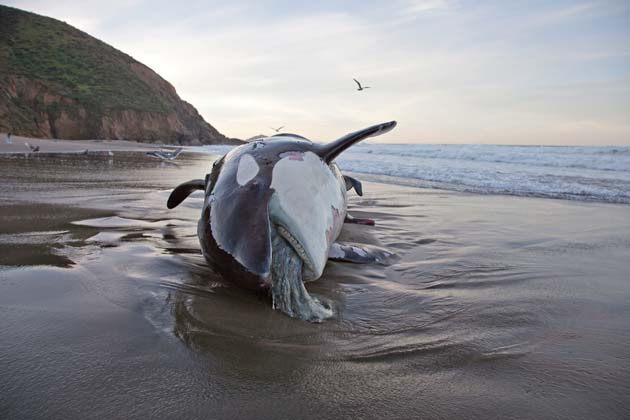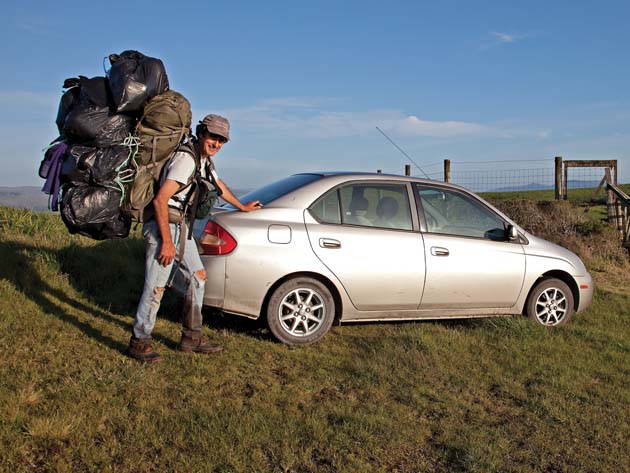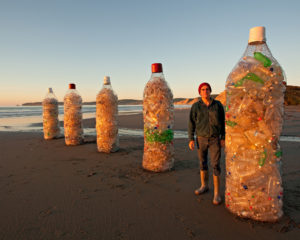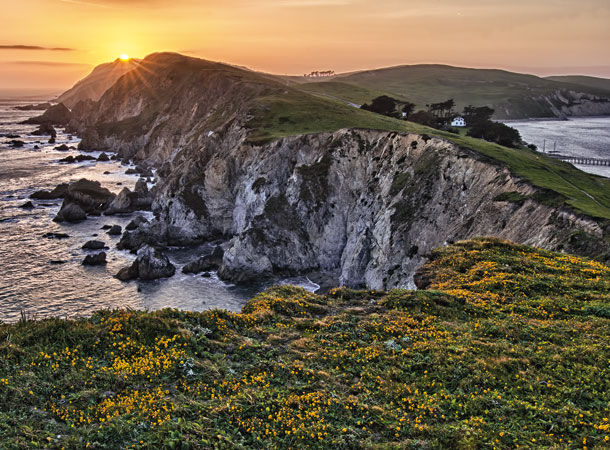From the western edge of the continent, Richard James blogs about life and litter at Coastodian.org, takes photos, and dreams up art projects that challenge our view of the world. Like the five giant bottles he fashioned out of plastic bottles washed up on the beaches and then arrayed like some dystopian Stonehenge at Drakes Beach. James and I went for a walk on North Beach at the Point Reyes National Seashore, where we sat down near one of the several trash caches he maintains, to talk about his life as a park volunteer and his mania for keeping the beaches clean. –Eric Simons
ES: What brought you to Point Reyes?
RJ: Nature. I was coming up to help as a volunteer with a salmon and steelhead monitoring project. I would drive up from Menlo Park, sometimes two or three times a week depending on the workload, and do fish work throughout the year. My first volunteer day was spent installing wattles above Horseshoe Pond. I helped with water quality, then all manner of salmonid monitoring. Then I got into plovers, elephant seals, harbor seals, invasive plant surveys, intertidal surveys . . . I made maps for other litter projects, and then started my own major litter removal operations.
But it was crazy. It’s a long distance, there’s bridge tolls, all that driving. And my rent kept getting raised, and I had an epiphany: Jeez, why don’t I move? So the fish brought me, initially, and once I got here I just started exploring the park.
ES: You left behind a past as a Silicon Valley tech worker, right?
RJ: Yeah, I had worked for different tech companies but at the time I was self-employed as a computer consultant in Silicon Valley. I just got burned out. I used to go to Macworld all the time. And then the last Macworld I went to I watched this guy give a demo on one of those first-person shooter games, and he was so excited that the latest model had the graphics processors that could very very realistically simulate blood. Look at that blood!
So I thought, instead of spending all this money to make Grand Theft Auto and all this crap that just pollutes children’s minds, why don’t you make a fully cyber zoo? Instead of having guys wear goggles where they control drones that kill people, develop that technology to let children have immersive experiences with animals so you don’t have to trap animals. People seem to be glued to their screens — well, let them look at their screens, and let those animals live, and protect them in the wild!
ES: How did you first notice the trash on the beach and think of this as a call to action?
RJ: I’ve picked up trash my whole life. In the city trash doesn’t stand out as much, because the city’s all human-contrived stuff. But out here, in contrast to sand and waves and birds and kelp, it really jumps out at you. I can’t really walk by. I just feel compelled to pick it up. Because if I don’t, who will?
I go to remote beaches and I pick up litter that no one gets to. I can easily find 100 to 200 pounds of litter on one beach. I grab what I can. You ask why the litter — why not? It’s horrible, all the damage that gets done. I’ve got a picture of a murre tangled up in a salmon rig, and I’m sure it drowned because of that. All the birds that eat this stuff, the turtles that eat balloons and plastic bags thinking they’re jellyfish, those whales with 300 to 400 pounds of fishing net in their gut that killed them, that’s just wrong.
ES: Do you remember at all the first time you came out to the beach out here and thought, I’m going to collect some of this stuff and bring it back with me?
RJ: I can’t remember the first time, but in the beginning I didn’t bring a backpack. I just had a jacket, and I would pick up bits and pieces and shove it in my pocket. Well, you can imagine, it doesn’t scale very well. Your 501 jeans only hold so much. So then I’d find a bait bag, or a plastic bag. But then I’d have bags full of stuff, and the bags would tear. So I’d have to find another bag, and then I thought, oh, maybe I should bring my own bags. For a while I would bring plastic bags, but that was just adding to the mess.
ES: You took some of this trash you collected and turned it into art: human-size bottles made from plastic bottles you found on the beach. Tell me about the origin of the exhibit.
RJ: All 2010, I’d been picking up bottles. I decided to store a year’s worth of bottles and make something of them. I hadn’t figured out what that was, but I had to do something, so I decided I’m going to make these giant meta-bottles. I made the chicken-wire frames, I had buckets to make the caps. I wanted to keep the aspect ratio of a real water bottle, just scaled up so it looked like a bottle. I made five of them. I got permission to drag them out onto Drakes Beach one morning, where I photographed them. I knew I wanted those iconic white cliffs of Point Reyes in the background.
ES: You’ve been out here enough to see the park in a lot of different ways. Can you talk about how that’s changed you and what you see out here?
RJ: It’s often a multi-mission: I come out here to photograph, I come out here to be here, I come out here to pick up trash. I’m always ready to pick up trash because it’s always here. Sometimes I play games where I’ll only pick up red things, or blue things. I’ll kind of tune my visual radar. And I’ve noticed that when I’m focusing on something, whether it’s a red thing, whether it’s a water bottle, whether it’s Styrofoam, whether it’s a float, it’s very easy to miss everything else. We’re destroying our planet because we get distracted by meaningless things. Being out here has taught me to look at things differently. I’ll be out here and I’ll be so focused on picking up trash — looking at the ground — that I have to thump myself upside the head, like, look at the waves! Because there will be huge waves, and it’s crazy! I think of all the people in skyscrapers in downtown anywhere, USA, that would die to be where I’m at, and I’m just mindlessly walking through this gorgeous scene picking up trash! So I’ll say, dude, look at the seagulls. Or 40 pelicans will fly by six inches off the deck and I’ll catch sight of them and it’s like, OK, stop what you’re doing, and revel. Revel in that beauty.

ES: You’ve seen a lot of remarkable natural moments. Like, you once saw two gray whales practically in the surf next to you.
RJ: Oh, yeah. That was up at Kehoe Beach. I actually went out there to gather some mussels to cook ’em for a friend. I go out there, and oh my god, that was incredible. Those whales were closer than from here to that kelp right there. A big one and a little one. And then there were bigger ones farther out. I’ve seen bull elephant seals, two-ton beasts duking it out, beating the tar out of each other. And I like pelicans; I call walking on the beach pelican therapy. A couple years ago, I probably took 10,000 photos of pelicans because I was so into pelicans. I got some good shots. I got a lot of not good shots.
ES: How’d you find out about the dead orca?
RJ: Well, I was in the midst of an art exhibit where I was exhibiting some of my work when I got a phone message from Moe Flannery at Cal Academy of Sciences, and she’s like, “Richard, there’s an orca, can you help?” Because there’s nothing like a cetacean to get a museum curator excited; I’ve learned that. I went, “Aw, man, I am sooo busy right now, um, OK, I’ll see what I can do.” I couldn’t do anything that day because of the show, but the next day, I got up at 5 in the morning, grabbed my camera gear, and hiked out there and went down to that beach, and here’s this orca in the surf. I took shots from the cliff right above it; then as I approached it I took some more shots, and took some video. But I didn’t have a lot of time, the surf was coming in, the whale was in the surf, and I had to get back to the show, so that was it for that first day. But then Moe and her crew came and took some tissue samples off the whale, and took pictures. Then they sent their pictures out to the orca network, if you will, and someone who knows orcas saw what’s called the saddle patch, which is kind of like the license plate for orcas, and they went, ohmygod, that’s o319, we know that whale — he was last seen off Vancouver. It was an Offshore orca, meaning it belongs to this orca ecotype that we don’t know much about. So Moe went holy crap, we need to get the whole whale. I got climbing gear, I got my backpack, and I went down there and helped with the slicing and the dicing. I photographed mostly, but since I was the guy with clean hands, I would give Moe water, I would give people tools. Then I helped them pack out the parts, doing four trips. I carried out both flippers, one [that was] kind of de-tissued but still very heavy, with two vertebrae, and then the next one, no-body de-tissued it, it was full-on flesh. Those flippers weigh 50, 60 pounds apiece. Plus two vertebrae again. I just got what I could get. I did a lot of trips for that whale.

ES: Was it a nice reward to see it so well articulated in the museum?
RJ: Yeah, that was cool. It’s gorgeous. Seeing that flipper, just the bones, it’s basically a big hand.
ES: Was that the only beached whale you’ve found out here?
RJ: No, in January 2008, just before I moved up here, a sperm whale washed ashore on that same beach where the orca washed ashore. I smelled it first, then I saw the bones, then I saw the net. So I documented it, I gps’d it, I took photographs. I thought, wow, this is incredible. A few months later, I came across five vertebrae on McClures Beach in the surf, intact. I called the park dispatch, because I didn’t know the park’s whale people yet, I only knew the fish people. And they said, “Oh, Sarah Allen’s going to want to know about this.” So I told them right exactly where it was, and they came down and got it. That was the first time I met Sarah. She subsequently learned how nutty I was and how much trash I was packing off the beach, so she said, “Well, you know, that sperm whale, all that net that was in its gut”— because that’s probably what killed it, that was one of three sperm whales that washed ashore on the Pacific coast that year, all males, all with big chunks of net in their gut —“would you pack that net off the beach?” So she loans me her little itty-bitty Kelty backpack and says, “Here, you can borrow my backpack because it’s going to stink.” Well, that thing wasn’t going to fit in that tiny pack! There was a lot of net! But Gregory Packs had learned what I was doing, and they gave me a backpack. It was a return, it was already destroyed. So I packed about 350 pounds of really stinky net off that beach in that pack. It took me five trips over two days. Later Moe and some other volunteers came out and we packed all the bones of that whale off the beach.
ES: Where does your love of the outdoors and nature come from?
RJ: I don’t know. My grandparents had a homestead, 160 acres in the foothills of California with cows and an apple orchard. So as a youth I picked apples and I dealt with steers. And I dealt with fixing fences. And then we would go deer hunting, dove hunting, quail hunting up there on the property. Fishing too; I was exposed to trout fishing as a child. But then in college that’s when I first started going backpacking. My friend took me on my first 10-day trip. We were in Kings Canyon, Sequoia. That’s my favorite home, up there in the Sierra. That’s when I really got the bug. I got to immerse my-self, get away from cars, get away from everything. And that’s when it all really blossomed.
ES: What are you working on now, with your art?
RJ: I’m working on a project about heat sinks. I don’t know if you’ve ever looked inside a big desktop computer but the little chip, just the size of your pinky fingernail, that little thing generates so much heat, they’ve actually got a very intricate aluminum or copper device inside the computer to bleed the heat off these chips. I’ve read about the Google and Apple and Amazon server farms that are literally built next to rivers or the ocean because they generate so much heat and consume so much electricity. So I’m trying to figure out a way to poignantly point out that we are wasting the resources of the planet just so Google can make money selling ads, so you can look up the best restaurant or who’s got the best Yelp rating. And we’re mining the planet for metals and rare-earth metals to generate all this technology and destroying the natural world in the process.
ES: It has to be frustrating to keep coming out here and keep finding trash — what do you do to remind yourself this is why we have to do this and maybe we can make it better?
RJ: Sometimes it’s very depressing. Sometimes I don’t come out. Sometimes coming out without a single bag, I’m not going to pick any trash up, which is really hard; I’m just going to focus on the beauty. Just let the sounds, the sights, the beauty nourish my soul. Sometimes I’ll get an email or a comment on the blog, someone will say, man, thanks. Thanks for what you do. That helps. Someone recognizing the effort. Because it’s a lot of work. I’ve destroyed my knees. Walking on loose sand with an 80-pound bag is not advised. I wouldn’t recommend it. Take smaller bags. Take smaller bites — even though there’s so much to bite out here. There’s so much trash. One thing I’ve learned, there could be a thousand Richards, or anybody else who’s out here doing it. The picking up isn’t the issue, it’s the putting in. We need to change. We are killing the ocean. The pendulum swings back and forth. I sometimes get very distraught at what we’re doing to the planet. To the sharks, to the turtles, to the whales, to everything. I frankly am not very hopeful. Because the bulk of society is too obsessed with gadgets and iPods and iPhones and things that don’t really matter. But I don’t stop. The human spirit is strong I guess. I don’t stop. I still come out.





-300x221.jpg)